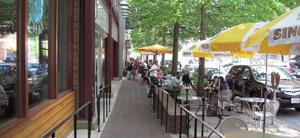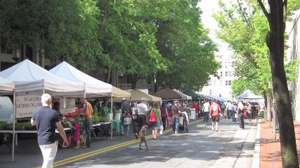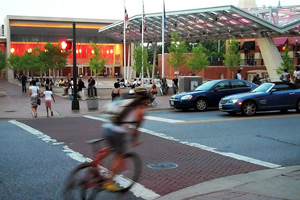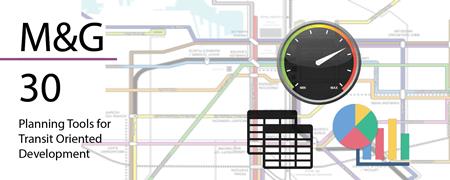Planning, Zoning and Development Review
Best Practice: Montgomery County’s Downtown Mixed Use Zoning
Bethesda and Silver Spring, inner-Beltway communities on Metro’s Red Line, were designed as central business districts (CBD), providing measures that incentivize density and set the stage for significant retail and office development near the Metro.
When the CBDs were established in the 1990s, property owners were given two choices of development methods: a standard method and an optional method that allowed greater densities in exchange for developer-provided public amenities to support that increased density.

 Bethesda, home to a Red Line Metro station, is the most urban area in Montgomery County.
Bethesda, home to a Red Line Metro station, is the most urban area in Montgomery County.
As the county underwent a
rewrite of its zoning ordinance in 2014, the county converted the CBD zones to
commercial-residential (CR) zones to provide more flexibility in land uses.. CR zones retain the development methods, but provide further incentives for greater density and height. The CR zones encourage a mix of commercial and residential to create 24/7 activity centers and provide flexibility to build place types that fit different communities. They incentivize public benefits, such as well-designed open spaces, affordable housing and strategies to retain small, neighborhood-oriented businesses. The family of zones allows for a range of densities and heights that taper down near single-family neighborhoods. Once mapped with specific density and height limitations, the zone provides certainty for residents about the type of development they can expect.
Bethesda
In 1970, as county leaders prepared for the arrival of Metrorail, the Planning Board reduced the size of the CBD to concentrate development but established a commercial transition zone to provide a buffer between the core and residential neighborhoods. In 1994, the Bethesda CBD Sector Plan called for “completing the Metro Core…the focus for most intense development, with high-quality infill structures, green open space and streetscape improvements such as trees, special paving and seating.”
In the late 1980s, the county enacted legislation authorizing the creation of an urban district in Bethesda in which properties are levied a special tax to pay for public services within the district. In the early 1990s, the Bethesda Urban Public/Private Partnership was created to control the distribution of the revenues collected in the district.
In 2014, the Montgomery County Planning Department began revising the Bethesda CBD Sector Plan to revisit land use and density, urban design, character and building height, and mobility.
Silver Spring
The Silver Spring Metrorail station was built outside the downtown so the Metro could run on railroad right-of-way. While downtown Silver Spring was a thriving business district in the 1950s and 1960s, it declined in the face of suburban mall competition in the 1970s and 1980s.
 Montgomery County planners re-envisioned downtown Silver Spring as an active mix of civic, retail and entertainment uses three blocks from the Metro station. Image courtesy Greater Greater Washington
Montgomery County planners re-envisioned downtown Silver Spring as an active mix of civic, retail and entertainment uses three blocks from the Metro station. Image courtesy Greater Greater Washington In 1992, redevelopment of the former Hecht’s department store brought new movie theaters and retailers, but the project was not large enough to halt the retail exodus. Montgomery County planners created a vision to remake downtown Silver Spring in the 2000 Silver Spring CBD Sector Plan that allowed mixed uses and created active streetscapes leading to the Metro station.
County officials committed to redeveloping Silver Spring’s core in the mid-1990s. An important step was luring Discovery Communications, which had decided to consolidate its Bethesda offices, to Silver Spring. A site plan for a 22.5-acre parcel along Ellsworth Drive in the downtown led to a redevelopment project that created a wildly successful streetscape flanked by stores and restaurants. On weekends and for special events, the street is closed to vehicular traffic and used as a pedestrian mall.
The county’s urban renewal plan for Silver Spring emphasized the role of cultural activities. The historic Silver Theatre on Georgia Avenue, which had fallen into disrepair and was slated for demolition, became a focal point. The theatre was part of the Art Deco-styled Silver Spring Shopping Center built in 1938 that closed after a 50-year run. A decade later, when its owner announced demolition plans, community preservationists waged a battle to preserve both the theatre and the adjoining shopping complex.
County officials took ownership of the building in 1996 and sought a tenant. They selected the American Film Institute, which agreed to restore the theatre. Today, AFI, which leases the building, draws movie buffs to both popular and off-beat films – independent features, foreign films, documentaries and classics.
A Montgomery County civic building and public plaza that opened in 2008 on Ellsworth Drive culminated revitalization efforts. The site serves as a public gathering place, with an ice rink in the winter and performances and fairs throughout the year. The building hosts community events, houses a gallery programmed by the Arts and Humanities Council of Montgomery County and serves as the home of the Silver Spring Regional Services Center and the Round House Theatre.
Like Bethesda, Silver Spring is an urban district that funds improvements and activities to promote downtown activities. The urban district managed by a committee that advises county government on management, and finances.
TOD Best Practices: Planning, Zoning and Development Review
